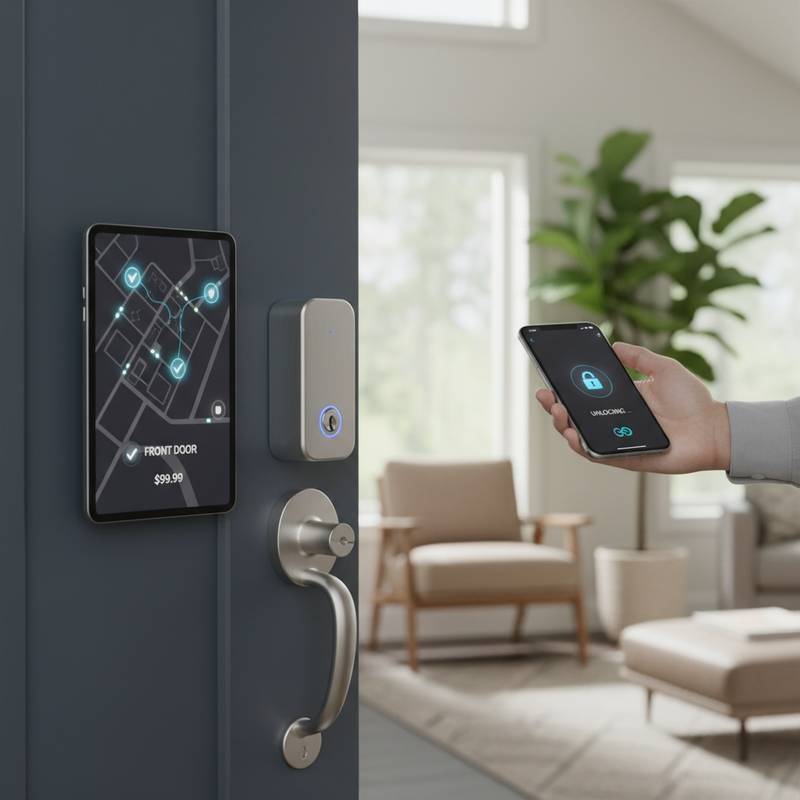Affordable Retrofit Smart Locks Lead 2025 Home Security Trends
Smart homes evolve from optional features to essential components of modern living. Retrofit smart locks under $100 exemplify this transition by fueling widespread adoption among homeowners and renters. These devices deliver superior security, simplified access, and an introduction to interconnected lifestyles, all at a fraction of previous costs and without demanding intricate installations.
Simplifying Installation with Retrofit Designs
Conventional smart locks frequently necessitate replacing the full door hardware, a process that deters many users. Retrofit models overcome this hurdle by mounting onto the existing deadbolt from the interior side of the door. Users retain their physical keys while gaining digital management capabilities.
This approach expands access to the smart lock market for diverse audiences. Budget-minded individuals, tenants, and those new to smart technology can enhance their entry points using basic tools or none at all. The combination of rapid deployment, added convenience, and economical security appeals to practical needs.
The Impact of Accessible Pricing on Adoption
Expense stands as a primary obstacle to embracing smart home technologies. Research indicates that purchase likelihood increases significantly when devices fall below $100, particularly those providing clear everyday advantages. For numerous families, this price point shifts a smart lock from an extravagant addition to a worthwhile enhancement.
Producers adapt by optimizing components and software for dependable operation at reduced rates. Progress in Bluetooth connectivity, low-power motors, and streamlined batteries enables these locks to rival higher-end counterparts. As a result, performance meets affordability, broadening participation in smart ecosystems.
Enhancing Daily Routines Through Smart Features
Top-performing retrofit smart locks under $100 excel by streamlining routine tasks. Consider returning home burdened with packages and activating the lock via smartphone or voice assistant. Alternatively, share a time-limited digital access code with a guest, eliminating concerns over lost physical keys.
Such functionalities extend beyond elite models to entry-level choices. Standard inclusions encompass mobile app integration, automatic locking schedules, and temporary access codes. Certain variants connect with prominent smart home systems, enabling unified control over doors, illumination, and temperature settings. This fusion of protection and fluidity propels the sector's rapid expansion.
Spotlight on Innovative Budget Options
Companies including Wyze, SwitchBot, and Lockly erase distinctions between economical and upscale offerings through retrofit innovations emphasizing value and dependability. The Wyze Lock Bolt employs Bluetooth for seamless pairing and supports fingerprint authentication alongside app controls. SwitchBot's solution utilizes a compact motorized unit to rotate the deadbolt automatically, preserving key compatibility for traditional use.
Lockly's contributions incorporate advanced encryption protocols with intuitive interfaces, assuring users of fortified digital safeguards. These developments arise from market rivalry and user preferences, fostering solutions that balance cost, usability, and effectiveness. Consequently, a vibrant category emerges where progress aligns with everyday accessibility.
Building Confidence with Robust Security Measures
Affordability need not imply reduced safeguards in security-focused devices. Numerous retrofit smart locks under $100 employ secure data transmission between the hardware and accompanying application, alongside multi-step verification processes. Detailed records of access events further empower users to monitor entries and exits precisely.
These elements, previously reserved for costly segments, now form baseline expectations. Heightened awareness of online threats demands that even inexpensive tools uphold stringent protective criteria. Manufacturers thus prioritize ethical advancements, guaranteeing that cost savings align with unwavering reliability and user assurance.
Entry Points to Expanded Smart Home Experiences
Beyond mere door protection, the rise of retrofit smart locks under $100 indicates evolving attitudes toward integrated living. For countless individuals, this device marks their initial foray into smart technology. The ease of remote operation often inspires further investments in areas like automated lighting, climate regulation, and power optimization.
This sequence advantages users and producers alike, establishing a cycle that hastens overall integration. Retrofit locks serve as foundational elements within broader networks, illustrating how modest changes can catalyze profound adjustments in daily habits and home management.
Embracing Security Tailored to Modern Needs
The momentum behind retrofit smart locks under $100 highlights the interplay of technological progress, competitive pressures, and user expectations in redefining smart residences. These tools merge uncomplicated setup with intelligent oversight, extending secure, connected access to wider audiences.
As costs decline further and capabilities grow, retrofit options will shape primary purchases and guide developments in adjacent categories. They embody an era of inclusive protection, where innovations conform to existing setups rather than requiring overhauls. For those initiating a smart home transformation, these locks deliver a compelling entry: advanced security remains within reach for all budgets.
